Photos by: Social Southern Hart | Interior Styling by: Jenn Fussell Interiors
Bringing the outdoors, indoors.
As a wildlife artist, that’s my ultimate goal and my highest calling. To bring the outdoor lifestyle that we love to the inside of your home, office, or hunt camp. Like most creative endeavors, the possibilities are endless. Art can be applied to just about anything these days, and it can complement any style - no longer limited to an original oil painting or even a framed canvas print.
With my latest series of paper prints, “The Growth and Maturity of the White-tailed Deer” and “The Waterfowl of North America,” we’ve gone to great lengths creating authentic pieces of art that celebrate the wildlife that we cherish most. With a vintage feel and simplified color scheme, they’ll look great in a variety of environments and fit any personal taste. These prints arrive rolled in a custom shipping tube, leaving it up to you to choose how you’d like to display them. If you’re in the mood for something other than flat art hung on the wall, here are a few ideas to get your creative juices flowing.
1| Make a STATEment
Use barn siding, palette wood, or something more polished and cut out the shape of your go-to state for waterfowl or whitetail hunting. Then, mount your print on top and trim it out. Because of the horizontal dimensions, these may not work well with vertical states (like my home state of Illinois). But if you’re in Iowa, Nebraska, or another rectangular state, these are flat out awesome.

2| Serve with Style
The first round of drinks or deer sausage and crackers could aways use an ice breaker. What better conversation piece than a serving tray with a whitetail print underneath? Imagine pointing out to your new neighbors exactly where that deer sausage came from.

3| Drink it All In
There’s no better focal point for the man cave or hunt camp than behind the mini-bar. Save the mantle for an original oil painting - this spot needs a wider selection…of art. Picture yourself cheers-ing a successful day in the blind in front of the species you hunted that morning. Tip: If you start confusing the Hooded Merganser with the Red-Breasted Merganser, you’ve had one too many. Time to go to bed.

4| (Table) Top if Off
It’s always the hub. It’s where you gather for the crucial 4:30 am cup of coffee before the hunt. It’s where you prop your wool-socked feet up mid-day to catch the first half of the game and a catnap. It catches peanut shells, Dixie cup rings, and the occasional gun cleaning. It’s the coffee table…and it’s the perfect platform for a wildlife print. Build your own table, buy a new one, or use an existing one. Add a piece of tabletop glass to protect the print and you’re ready to roll.

5| Think Inside the Box
Not sure how to display your coffee can full of arrowheads? Have a couple of old arrows laying around that you just can’t part with for sentimental reasons? Show them off in a shadow box. When I was growing up, the Illinois DNR issued deer pins when you took your deer to the check station as a little round souvenir for your success. Old-timers wore them on their hats, collecting them like an all-conference quarterback covers his helmet in stickers. You can easily build a shadow box with room for these items around your print, telling a unique story of decades spent in the woods and on the water.
6| Stick it on the Shelf
Even muddy hunt camps need a mudroom. The catch-all shelf for your bow release and cell phone while you take off the outer layers to meet up with your crew post-hunt (see coffee table or mini-bar options above). Take a rustic shelf and mount your print above for some good mojo at the front door as you come and go from the woods.
7| Put it to Work
Scrap that boring six-month calendar on your desk at the office - you have an iPhone for that now anyway. It’s so much cooler to take the waterfowl of your favorite flyway and put it to work. You can buy a clear plastic cover for it, or slide it under a piece of tabletop glass. Besides, you need a daily reminder of why you actually go to work in the first place.

8 | Record Your Slam
Fewer things could be more rewarding for the waterfowl hunter than bagging every species of your preferred flyway. Display your flyway print in camp or at home and write the date and location of each species you harvest as you cross them off your bucket list. Imagine if your duck hunting mentor, whether it be grandpa, dad, or a family friend, had done this over their hunting career and handed it down to you. Now imagine doing it for yourself and passing it down to the next in line in your own family.
9| Take it to the Field
Nobody says you’ve got to keep your print indoors. Laminate it and hang it in the duck blind (I’ve seen duck blinds nicer than most hunt camps, by the way). It’ll pass the time when the skies are empty and provide a great teaching tool for the youngster or new hunter in the group. As you bag a species, let them point it out on the print and see more details, like the current estimated population. Who knows, it may ignite the fire in a youngster to become the next great conservationist.

10| Build a Frame from the Farm
The back 40 holds bushels of memories. Snag some barn siding from the old home place or a piece of driftwood from your favorite river bank and create a frame that means something to you. Our own family farm had a barn that fell in overtime, and the molded wood that covered the slats between boards makes awesome trim work and frames. I took one strip, cut it to length at 45-degree angles, and used finishing nails to tack it right to the barn wood wall in my office. It doesn’t have to be a daunting task requiring the precision of a master carpenter - rough wood looks better a little unfinished anyway. Besides, it’s the rough edges that tell the best story.
Now, it’s your turn. Choose your print below and get started today creating your own masterpiece.








